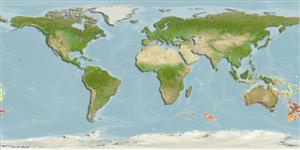>
Gadiformes (Cods) >
Euclichthyidae (Eucla cods)
Etymology: Euclichthys: Greek, eukleia, -as = fame, glory (Ref. 45335); polynemus: McCulloch (1926) did not discuss the derivation of the epithet but presumably is a combination of
the Greek poly (many, very) and nema (thread) in allusion to the long, thread-like appearance of the pelvic-fin rays (see also Etyfish website, https://www.etyfish.org/?s=Euclichthys+polynemus).
Environment: milieu / climate zone / depth range / distribution range
Οικολογία
Θαλασσινό(ά) βενθοπελαγικό; μη μεταναστευτικό(ά); εύρος βάθους 250 - 920 m (Ref. 33321). Deep-water
Indo-West Pacific: southern and western Australia and New Zealand.
Μέγεθος / Βάρος / Age
Maturity: Lm ? range ? - ? cm
Max length : 35.0 cm TL αρσενικό/απροσδιόριστο; (Ref. 1371); common length : 22.5 cm NG αρσενικό/απροσδιόριστο; (Ref. 5755)
Short description
Κλείδες προσδιορισμού | Μορφολογία | Μορφομετρία
Ραχιαίες άκανθες (συνολικά) : 1; Μαλακές ραχιαίες ακτίνες (συνολικά) : 85 - 95; Εδρικές άκανθες: 1; Μαλακές εδρικές ακτίνες: 85 - 102; Σπόνδυλοι: 66 - 69. This species is distinguished by a set of the following: body depth at anal-fin origin 15-18% SL; greatest body depth 1.1-1.4 times length of longest first dorsal-fin ray; horizontal snout length 3.6-4.5% SL; eye relatively large, horizontal diameter 6.1-7.2% SL, 1.4-1.6 times interorbital width; interorbital width relatively broad 4.4-5.0% SL; orbit-upper jaw width 1.9-2.6% SL; caudal peduncle depth 1.5-2.1% SL; caudal-fin length 4-11 times caudal peduncle length; anal-fin base is relatively short, length 50-53% SL; length of longest pelvic-fin ray 29-37% SL, 1.9-2.7 times length of longest first dorsal-fin ray; length of longest first dorsal-fin ray 13-15% SL; no accessory caudal-fin bones X and Y; first ventral procurrent ray linked to hemal spine of vertebrae 10-12; dorsal-fin rays total 85-95; anal-fin rays total 85-102; pectoral-fin rays 19-20; caudal-fin rays 38-45; primary rakers in outer gill arch 23-25; total vertebrae 66-69; scales relatively large, ~20 in transverse line from anal-fin base posteriorly to dorsal margin of body (Ref. 122017).
A benthic species (Ref. 75154) which occurs on the upper continental slope (Ref. 9563, 75154).
Life cycle and mating behavior
Γεννητική Ωρίμανση | Αναπαραγωγή | Γεννοβολία | Αβγά | Γονιμότητα | Προνύμφες
Last, P.R. and J.J. Pogonoski, 2020. Revision of the fish family Euclichthyidae (Pisces: Gadiformes) with the description of two new species from the Western Pacific. Zootaxa 4758(2):231-256. (Ref. 122017)
IUCN Red List Status (Ref. 130435: Version 2024-2)
Threat to humans
Harmless
Human uses
Εργαλεία
Special reports
Download XML
Διαδικτυακές πηγές
Estimates based on models
Preferred temperature (Ref.
123201): 2.8 - 13.4, mean 8.9 °C (based on 300 cells).
Phylogenetic diversity index (Ref.
82804): PD
50 = 1.5000 [Uniqueness, from 0.5 = low to 2.0 = high].
Bayesian length-weight: a=0.00389 (0.00180 - 0.00842), b=3.12 (2.94 - 3.30), in cm total length, based on all LWR estimates for this body shape (Ref.
93245).
Τροφικό Επίπεδο (Ref.
69278): 3.6 ±0.5 se; based on size and trophs of closest relatives
Fishing Vulnerability (Ref.
59153): Low vulnerability (25 of 100).
